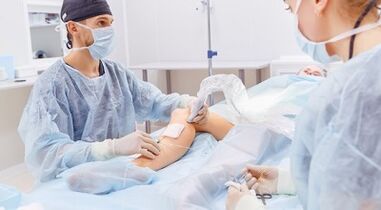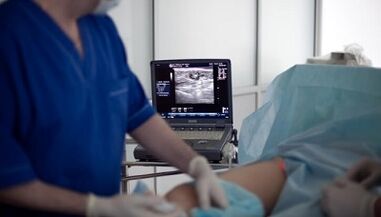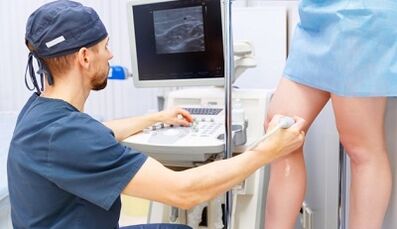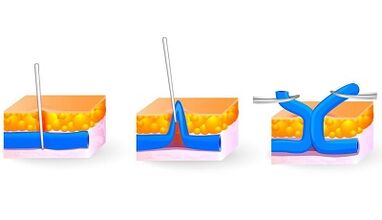
For many decades, the surgical treatment of varicose veins of the legs remains the only radical method of eliminating this disease and its complications.
Thanks to modern technologies and improvement of service techniques, it is really effective in both therapeutic and cosmetic terms, it is possible as easy and painless as possible, well tolerated by patients and does not cause prolonged damage.
Indications and contraindications
It is not advisable to operate patients with any varicose veins.There are clear indications of surgery and contraindications for its performance.
Surgical treatment of varicose veins of the lower limbs is indicated in the following cases.
Medical indications- expressed enlargement of veins of 2-3 degrees, accompanied by complaints and signs of chronic venous insufficiency:
- convincing, tense veins under the skin;
- numerous variants (nodes) along the modified vessels;
- swelling of the affected leg;
- severity and pain on the enlarged vein;
- Convulsions in the calf muscles on the lower legs when "reduces the legs;
- Inflammatory changes in the veins - thrombophlebitis;
- Trophile skin disorders-dark spots, redness, sealing of the subcutaneous layer, a long robbed wound-saying.
Cosmetic indications- early (first) stage of varicose veins without signs of venous insufficiency, leading to only cosmetic defect and aesthetic discomfort in the patient:
- superficially arranged slightly extended and confused veins;
- Vascular "stars", "spider" and reddish-blue small capillaries in the skin of the feet.
It is important to remember that even if there are indications of the operation, one must refuse if the risk of it exceeds the benefit.
The main contraindications for the surgical treatment of varicose veins:
- The serious general condition caused by acute (heart attack, stroke, pneumonia) began chronic diseases (liver, heart, pulmonary defects) or an old age of the patient.
- Any acute infectious diseases.
- Provable cancer treatment.
- Anemia is pronounced.
- A clear increase or decrease in blood coagulation.
- Inflammatory and reputation processes (assessments, rashes) on the skin of the lower limb, where surgery is planned.
- Pregnancy and early postpartum period.
All contraindications, with the exception of the former, are considered relative.This means that in special circumstances (acute dangerous conditions caused by varicose veins, for example, thigh thrombophlebitis), one or the other volume of surgical treatment should be performed.
When an emergency operation is required
Emergency surgical treatment of varicose veins of the legs can only be required in one case - with acute upward thrombophlebitis.This complication is an inflammation inside the lumen of a large subcutaneous vein, accompanied by the formation of blood clots.

If such a pathological process is applied to the thigh, there is a risk of blood clots to a deep venous system.In the case of the separation of such a blood clot, it penetrates the vessels of the lungs and clogs them, which causes a threatening life of a dangerous disease - pulmonary thromboembolism (pulmonary fiber).
The main manifestations of the increasing thigh thrombophlebitis:
- pain along the vein on the inner surface of the thigh;
- redness and fever of the skin;
- The seal of the changed area and its acute pain on palpation.
With ascending thrombophlebitis, the volume of surgical treatment can be presented:
- Crosectomy - dressing and intersection of a large subcutaneous vein at the point of merger with poor;
- Removing a changed vein after pre -dressing.
The goals of surgery
Usually about 30% of the blood from the lower limbs flow through small subcutaneous venous tributaries, which merge into two central venous trunk - large and small subcutaneous veins.These vessels are directly related to deep veins through which 70% of the blood flow out.In the places of such compounds, there are valves that pass blood only from superficial veins to deep.
There are also dozens of small veins, which are called perforated, further connecting the surface venous network with a deep.They also have valves that only pass blood in one direction.
The main cause of varicose veins is the failure of the venous valves, which leads to incorrect release of the blood: from deep veins to a surface, which increases the pressure in them and leads to enlargement of both small vessels and central venous trunks.
The main goals for which surgical treatment is aimed at varicose veins of the lower limbs:
- Eliminating blood stagnation in altered superficial veins of the legs, which will prevent the progression of chronic venous insufficiency and trophic disorders on the skin.
- Removal of deformed vessels and varieties representing a cosmetic defect.
- The elimination of the discharge of blood from deep veins into superficial - ligation and intersection of a perforated (clans) veins, as well as large and small subcutaneous veins in the places of their relationship with deep ones.
- Prevention of repeated appearance of varicose veins.
Preparing for surgery
Complete preparation for surgical treatment of varicose veins includes:
- A general preoperative examination that allows you to evaluate the patient's blood and urine tests, coagulogram, biochemical analysis, blood type and Rh factor, syphilis tests, blood sugar level, lung radiography, ECG.
- A special diagnosis that allows you to determine the characteristics of the disease - ultrasound with color Doppler surface mapping, deep veins and arteries of the lower limbs and indicate the location of insolvent veins.
- The operation is performed on an empty stomach, so you cannot eat and drink in the morning on the day of surgery.
- In the morning before surgery, it is necessary to carefully shave all the hair of the inflamed leg from the groin to the foot.
Treatment of female varicose veins

Separate place in the surgical treatment of female varicose veins of the lower limbs belongs to cosmetic surgery.After such interventions, not only pathologically altered veins, but also postoperative scars on the skin of the feet or they are imperceptible.
In order to achieve maximum cosmetic effect, surgical surgery for varicose veins is performed according to the following methods:
- Laser or radio frequency ablation veins-To the central trunks of a large and small subcutaneous vein under the ultrasound control through the piercing of the skin of the thigh or on the foot.
- Stem sclero and sclerotherapy-Fulfillment of large and small subcutaneous veins, as well as all their tributaries, even the smallest ones, with a special sclerocautant medicine.
With some of the treatment methods described, varicose veins are not removed, but converted from blood vessels into soft cicatric tissue.Both physical influences (laser rays, radio frequency waves) and chemical compounds (sclerosants) destroy the inner layer of the vein.Thanks to this, it loses the lumen, adhesive and completely enhanced by the blood, becoming a simple connective (cicatric) tissue.
Thus, without direct removal of the veins, all the targets that are assigned to the rapid treatment of varicose veins of the lower limbs - the changes eliminate the changes in them and eliminate the dangerous consequences of venous insufficiency.
The only restriction of cosmetic surgery in the treatment of varicose veins in women is only possible mild or limited varicose veins up to 1-2 degrees.During pregnancy and in the early postpartum period, surgical treatment is contraindicated with the exception of acute situations requiring emergency intervention, such as upward thrombophlebitis.The operation is limited to the dressing of a large subcutaneous vein at the site of its relationship with the femur (the cross).
Types of surgery
Consider the most common surgical interventions in the treatment of varicose veins of the lower limbs: laser ablation, endoscopic dissection of the veins and phlebectomy.
The latter is divided into the following types:
- Classic operation or complete undressing or work of Troyanov-Trendelenburg-Bubo-Narara;
- short undress;
- Miniyphobectomy.
Flbectomy
Removal, extracting veins from the skin is called phlebectomy.This is one of the first methods for surgical treatment of varicose veins of the lower limbs.But even today, phlebectomy is most often performed by phlebology and vascular surgeons.There are three modifications and methods of work: full, short undressing, mini -fushkabectomy.
The volume of intervention is presented:
- As a bandage of the trunk of a large subcutaneous vein at the site of its fusion, 2-3 cm on the thigh under the inguinal fold, in the thigh, through a cut.
- Removing it through the step to the foot, using a special probe through two cuts of the skin 1-2 cm along the inner surface near the knee and ankle.
- The removal of all varicose veins and small veins through separate small incisions is about 1-2 cm (they can be from 5-6 to 10–20) with the dressing of insolvent perforative vessels.
- Sewing all wounds with cosmetic stitches.
The classic phlebectomy most radically allows you to remove varicose veins, but the most traumatic of all existing techniques.
Brief
With a short removal, the entire large subcutaneous vein is not removed, but only its fragments affected by varicose veins, for example, only the thigh or lower leg.Healthy segments are not removed.This reduces the injury of the intervention, but the risk of recurrence of the disease remains.Otherwise, surgery surgery is similar to classic phlebectomy.
MiniFo -Bectomy

The innovative methodology for the removal of small varicose veins of a large subcutaneous vein is called miniflebectomy.
Its implementation requires special tools (pointed scalpel, hooks, brackets, spatula), with which the veins are extracted through the skin of the skin several millimeters.It is not necessary to sew such skin defects, the scars are invisible.
Most often, surgeons combine a short or complete undressing of a large subcutaneous vein with a miniFectomy.Such a combined operation combines radicalism and minimal trauma with good cosmetic effect.
Vein endoscopic dissection
Finding all lower perforation veins during any phlebectomy is difficult.Endoscopic equipment (video camera and manipulators) is used for these purposes.Through small cuts in 1-2 cm, they are placed under the skin in places from punch veins, which are found with ultrasound.
Under the control of the camera, all the more low perforators find, turn and cross them.During this operation, subcutaneous veins are not removed.It can be performed both independently and in combination with any type of phlebectomy: undressing, miniFectomy.
Laser treatment
Laser ablation for varicose veins involves burning with a laser beam of a large subcutaneous vein beyond its clearance.To do this, by drilling the skin of the thigh or in the ankle area into the lumen of the vein, the entire length is introduced by a catheter-vertist.Under ultrasound control, Svetovod is slowly extracted.
The laser beam acting on the venous wall destroys the inner layer.As a result, Vienna falls and ceases to function, which is clearly visible on the ultrasound monitor.If not only the main venous trunk, but also its tributaries, are removed with varicose veins, they are removed according to the method of miniflebectomy.
Rehabilitation
No matter what operational methods for the treatment of varicose veins have been used, the restoration of patients in the postoperative period occurs quickly.The conditions of complete rehabilitation depend on the methodology of surgery, the stage of the disease and the general condition of the patient.With laser treatment and mini-firm-in-law of the initial varicose veins, this is 2-3 weeks, with a classic phlebectomy for advanced forms of the disease 1-3 months.
The walk is recommended as early as possible, provided that the condition stabilizes after anesthesia -after 5-6 hours.If spinal anesthesia is performed, rest in bed is recommended within 12 hours.With local anesthesia, the patient can leave the operating room on his feet and is not even hospitalized in hospital.The main condition before walking is to turn the feet with an elastic bandage or to put an individually selected folding compression.
Stay in the hospital for 1-2 to 5-8 days.If the seams have been overlapped, it is better to remove them 7-8 days during a specialist check.Within a month after surgery, it is recommended to wear compression knitwear.You need to put it daily before you get out of bed.At night, compression products are removed.After a classic phlebectomy with severe varicose veins, it is better to continue compression for up to 3 months.
Throughout the month, it is strictly prohibited:
- Sauna and hot bath;
- severe physical activity of the lower limbs;
- Long stay in a fixed position, standing or sitting.
Possible complications
The most common complications associated with varicose veins:
- Pain in the operated leg as a result of damage to large nerves.
- Long -the swelling of the lower part and legs.
- Hematomas and bruises on the lower part and thigh.
- Bleeding from wounds.
- Flbotrombosis - inflammation of deep veins.
- Supervision of postoperative wounds and necrosis (deadly) of the skin around them with the formation of trophic ulcers.
- The formation of gross postoperative features.
Thanks to modern methods and technologies, the surgical treatment of varicose veins is easy, painless and of high efficiency.Compliance with all recommendations from the postoperative period contributes to rapid recovery, minimizing the risk of complications and recurrence of the disease.























